- Literary Terms
- Definition & Examples
- When & How to Use Paraphrase

I. What is a Paraphrase?
A paraphrase (pronounced par – uh -freyz) is a restatement or rewording of a paragraph or text, in order to borrow, clarify, or expand on information without plagiarizing. Paraphrasing is an important tool to use when writing research papers, essays , and pieces of journalism.
II. Examples of Paraphrasing
For examples of paraphrasing, consider these possible re-wordings of the same statement:
She angered me with her inappropriate comments, rumor-spreading, and disrespectfulness at the formal dinner table.
She made me angry when she was rude at dinner.
This paraphrase is an example of a rewording which shortens and simplifies while maintaining the same meaning.
Her impoliteness, gossiping, and general lack of respect at dinner infuriated me.
This rephrasing maintains the same meaning but is rearranged in a creative way.
I was mad when she started spreading rumors, making inappropriate comments, and disrespecting other guests at our dinner.
Another paraphrase, this rewording properly and interestingly rearranges the information provided in the original sentence.
III. Types of Paraphrasing
A. change of parts of speech.
Parts of speech ranging from verbs and nouns to adjectives and adverbs are replaced with new parts of speech in this type of paraphrasing. Here is an example:
Original Sentence:
The boy quickly ran across the finish line, seizing yet another victory.
Paraphrase:
The quick boy seized yet another victory when he ran across the finish line.
In this example, many parts of speech are changed: the adverb quickly becomes the adjective quick, and the verb phrase with the gerund seizing becomes the verb seized.
B. Change of Structure
This type of paraphrasing involves changing the sentence’s structure, sometimes creating a passive voice from an active voice and vice versa. The change in structure can be used to reflect the writer’s interpretation of the original quote. Here is an example of change of structure paraphrasing:
Puppies were adopted by numerous kind souls at the puppy drive.
Many kind souls adopted puppies during the puppy drive.
In this example, the object of the sentence (kind souls) becomes the subject with an active voice (adopted) rather than a passive voice (were adopted).
C. Reduction of Clauses
Reduction of clauses paraphrases reduce the number of clauses in a sentence, which can be interruptive or confusing, by incorporating the phrases into the sentence. Here is an example of reduction of clauses paraphrasing:
While I understand where you’re coming from, and truly respect your opinion, I wish you would express yourself more clearly, like Clara does.
I understand where you’re coming from and respect your opinion, but I wish you would be more like Clara and express yourself more clearly.
D. Synonym Replacement
Synonym replacement paraphrasing is one of the simplest forms of paraphrasing: replacing words with similar words, or synonyms. Here is an example:
The older citizens were honored with a parade for those once in the military.
Senior citizens were honored with a march for veterans.
In this example, many synonyms are used: older citizens are senior citizens, a parade becomes a march, and those once in the military refers to veterans.
IV. The Importance of Using Paraphrase
Paraphrasing is a way of referencing a source without directly quoting it or of further explaining a selected quote. Correct paraphrasing is important in that poor paraphrasing can result in accusations of plagiarism, or copying from a source without correctly citing it. Paraphrasing allows writers to examine the meaning of others’ work, creatively rephrase their statements, and craft information to suit an essay or composition’s goal or focus.
V. Paraphrase in Literature
Paraphrasing can be found in a variety of journalistic sources from newspapers to film documentaries to literary journals. Here are a few examples of paraphrasing in literature:
Someone once wrote that musicians are touched on the shoulder by God, and I think it’s true. You can make other people happy with music, but you can make yourself happy too.
In John Berendt’s nonfiction novel Midnight in the Garden of Good and Evil , a character references what someone has once written by paraphrasing their message.
I’m going to paraphrase Thoreau here… rather than love, than money, than faith, than fame, than fairness… give me truth.
In this example from the nonfiction novel Into the Wild , Jon Krakauer paraphrases Thoreau’s larger message of transcendence.
So far, Laurance’s critiques of new road-building schemes have been well received, but he expects that to change.
In Michelle Nijhuis’ article “What Roads Have Wrought,” William Laurance is paraphrased rather than quoted to express his general viewpoint.
VI. Paraphrase in Pop Culture
Paraphrasing is often found in pop culture when attempting to translate the language of older plays, poems, and stories, such as Shakespeare’s works. Here are a few examples of paraphrasing in pop culture:
10 Things I Hate About You (1999):
Just a minor encounter with the shrew… the mewling, rampalian wretch herself.
In the modern-day adaptation of Shakespeare’s The Taming of the Shrew , many characters ’ lines paraphrase Shakespeare’s originals. Here is Shakespeare’s version:
A meacock wretch can make the curstest shrew.
A Different World: Romeo, Oh Romeo
First, the student reads Shakespeare’s original words:
Oh gentle Romeo. If thou dost love, pronounce it faithfully. Or if thou thinkest I’m too quickly won, I’ll frown and be perverse and say thee nay, so thou wilt woo.
Then, she paraphrases to translate its meaning for modern ears:
It’s all about translation. Oh, sweet thang Romeo. If you think I’m all that, then step to me correctly. But if you think I’m a skeeze, I’ll be dissin’ and dismissin’, then you’ll be workin’ overtime getting’ me back.
VII. Related Terms
Like paraphrases, summaries are rewordings of original statements. Whereas paraphrases are precise and specific, summaries are brief and selective. Summaries report main points in a shortened version of the original, whereas paraphrases simply restate the original statement in a new way. Here is an example of summary versus paraphrase:
Original Statement:
At the party we had delicious red punch, a bunch of different appetizers, and a cookout. Since it was at the park, we played volleyball, went swimming, and sunbathed for fun.
At the party we enjoyed food and drink and various outdoor activities.
Here, the summary purposefully shortens the original statement while covering its major points.
At the party we drank some punch, ate a handful of appetizers, and had a cookout. The park allowed us to enjoy a number of enjoyable activities from volleyball to swimming to sunbathing.
As this example shows, the paraphrase rephrases the original statement and keeps more of its original content than the summary.
Translation
Although paraphrase sometimes translates difficult phrasing into more understandable phrasing, it is not literally considered translation. For something to be a translation, it must change writing in one language to another language. Here is an example of translation versus paraphrasing:
Original Phrase:
That’s life.
Translation into French:
C’est la vie.
That’s just how life goes sometimes.
Although we loosely may refer to paraphrase as translating ideas, technically it is not a tool of translation.
VIII. In Closing
Paraphrasing is an important tool for nonfiction writers, journalists, and essayists alike. It is a common proponent of news and reporting. Correct paraphrasing protects writers from plagiarism and allows them to creatively rephrase original works, incorporating them into their own compositions.
List of Terms
- Alliteration
- Amplification
- Anachronism
- Anthropomorphism
- Antonomasia
- APA Citation
- Aposiopesis
- Autobiography
- Bildungsroman
- Characterization
- Circumlocution
- Cliffhanger
- Comic Relief
- Connotation
- Deus ex machina
- Deuteragonist
- Doppelganger
- Double Entendre
- Dramatic irony
- Equivocation
- Extended Metaphor
- Figures of Speech
- Flash-forward
- Foreshadowing
- Intertextuality
- Juxtaposition
- Literary Device
- Malapropism
- Onomatopoeia
- Parallelism
- Pathetic Fallacy
- Personification
- Point of View
- Polysyndeton
- Protagonist
- Red Herring
- Rhetorical Device
- Rhetorical Question
- Science Fiction
- Self-Fulfilling Prophecy
- Synesthesia
- Turning Point
- Understatement
- Urban Legend
- Verisimilitude
- Essay Guide
- Cite This Website
Examples of Paraphrasing

Paraphrasing is a great technique that can be helpful to different types of writers. However, people who may have not used this technique before could be a little confused as to what it actually is and how it can be practiced.
In this post, we’re going to be starting at the bottom by looking at what paraphrasing actually is. Then, we’ll move on to look at some of its examples so that you can get an idea about how you can incorporate them into your own writing.
Let’s get started.
What is Paraphrasing?
Before we go into all the details, let’s first understand the basics of paraphrasing.
So, paraphrasing can be defined as the process in which a particular piece of content is rephrase using different words and phrases so that it looks different, but has the same meaning as the original.
Paraphrasing can be done for multiple reasons. Oftentimes, it can be done to portray an idea or concept with better clarity. It can also be done when a writer wants to borrow someone else’s words but without directly plagiarizing them.
There are a lot of different uses of paraphrasing, and as we said at the start, they can be useful for different types of writers.
Now that we’re done with the basic definition, let’s move ahead to discuss some examples of paraphrasing.
Paraphrasing is not of a single type. There are various modes and approaches for it.
For example, if someone wants to only change a piece of content lightly and not completely alter it, they can just opt for the standard ‘synonymizing’ technique.
On the other hand, if someone wants to completely change the look of the content and to publish it as their own, they will have to do a lot more.
So, considering these varying levels of paraphrasing , we’ll divide our examples in different categories and look at them one by one.
Let’s start with the most basic type i.e., the synonymizing approach.
1. Basic Paraphrasing (Synonymizing) Examples
As we said above, this type of paraphrasing is suitable if the purpose is not to completely revise the content. Rather, it can be useful in situations where someone needs to make a few changes for the sake of explaining the content with more clarity and accuracy.
In this approach, only a few selected words in the content are changed with their synonyms. Nothing else is done.
Let’s look at some examples of this method before moving on to discussing the other types.
Original Text: John found the dog to be very heavy. He lifted him and heaved to carry him back home. Once he was at the front door, John realized that he had been carrying a bear instead.
Paraphrased Text: John found the hound to be very weighty . He picked him up and heaved to carry him back home. Once he was at the front gate , John understood that he had been lifting a bear instead.
Original Text: John could not understand why his mother had added candies to the curry. He picked one up and put it in his mouth, just to realize that it was a red chili pepper.
Paraphrased Text: John could not comprehend why his mother had added toffees to the gravy . He lifted one up and put it in his mouth, only to realize that it was a red chili pepper.
Related topic: Difference Between Paraphrasing And Rephrasing
2. Moderate Paraphrasing (Synonymizing + Phrase Changing) Examples
This type of paraphrasing is one level above the basic type of paraphrasing we discussed just now.
In this type of paraphrasing, not only the words are changed with their synonyms, but the phrases as well.
As a result of changing the phrases, the structure of the sentence also gets changed a bit, but not a lot.
This type of paraphrasing can also be done when the intention is not to pass off some content as one’s own. That is so because even after the content has been paraphrased using this technique, it can be identified and matched with the original.
Nevertheless, here are some examples of moderately paraphrased sentences.
Original Sentence: There was no one in the street when John came to it in his car. However, he could see that the cats were watching him very suspiciously.
Paraphrased Sentence: Nobody was in the street when John came to it in his vehicle . However, he observed that the felines were watching him with suspicion.
Original Sentence: John could not understand where all his furniture had gone. Someone had put other stuff in his rooms. His kitchen was also looking different. When he heard the police sirens, John realized that he was walking in someone else’s home.
Paraphrased Content: John was in a quandary about where all his furniture had gone. Some had placed different things in his rooms. His kitchen also appeared different . After hearing the police sirens , John understood that he had been roaming around someone else’s home.

3. Advanced Paraphrasing
“Advanced” paraphrasing can be referred as the type of paraphrasing in which the content in question is completely modified. This involves, apart from changing the synonyms and the phrases, altering the sentence structure and order.
This sort of paraphrasing can be done when the intention is to make the content appear totally different from the original. For example, if someone wants to use an idea from a source without giving it (the source) the due credit, they can paraphrase it in this way.
Let’s look at some examples of this type of paraphrasing:
Original Sentence: The road was empty except for a big truck. John thought he could easily dodge it. He sped up his vehicle. The truck, however, revved and kept on coming head-on.
Paraphrased Sentence: John thought he could easily bypass the solitary truck on the road. He revved his car but the truck kept coming straight at him.
Must Read: How And Why to Paraphrase Your Content?
Hopefully, after looking at these examples, you know a bit more about paraphrasing and how it can be done in different styles.
Paraphrasing is a useful technique, and it can be particularly helpful for writers who have to come up with the content on a regular basis. By paraphrasing content, writers can also actively incorporate research into their work without worrying about committing plagiarism.
Paraphrasing Examples: Top 5 Ways to Use Paraphrasing
Study these 5 paraphrasing examples to learn how to paraphrase when writing research papers and essays.
When writing a research paper or other project, you often need to work with other people’s writing. While you could easily put together a piece using many direct quotations, learning how to take someone else’s work and paraphrase it in your own words is valuable in your writing toolbox.
A good paraphrase keeps the author’s main ideas intact but says them differently. It shows that you have fully understood the information and can rephrase it to fit your overall piece’s writing style and tone.
As you learn to paraphrase, remember that you must still cite the original author. Unless the idea you are referencing is common knowledge in the field you are writing about, you must tell where the idea came from. In-text citations , as well as a bibliography page, are both essential.
As you consider how to change the wording of the original piece to fit your writing, looking at different paraphrasing examples will help you get a feel for what this rewriting looks like.
1. Paraphrasing Sentences by Changing Verb Tense
2. paraphrasing sentences by using synonyms, 3. paraphrasing an original work by changing the writing style, 4. paraphrasing paragraphs, 5. paraphrasing an entire work.

One way to paraphrase is to change the verb tense of the source material. For example, if it is written in passive voice, you could change it to active voice. If written in the past tense, you could change it to present or future tense.
Here are some examples:
- Original: Giraffes will eat Acacia leaves and hay, eating up to 75 pounds a day. (future tense)
- Paraphrase: A giraffe eats up to 75 pounds daily, including Acacia leaves and hay. (present tense)
- Original: Influenza can cause a runny nose and fever. (active voice)
- Paraphrase: People with influenza have experienced fevers and runny noses. (passive voice)
Changing the tense of the verbs may be all you need to do to adjust the sentence enough for it to be a paraphrase.
Another way to paraphrase your original passage for your research paper is to use synonyms for words. This will convey the same meaning without using the original author’s exact words. Remember that you still need to provide a citation using MLA or APA formatting to avoid plagiarism if the idea is the same as the source, but using synonyms is a great restatement option. Here are some examples:
- Original: In Santiago, COVID-19 dealt the hardest blow to people with low socioeconomic status, because of factors such as crowded households, a lack of health care, and an inability to work from home.
- Paraphrase: Because few people could telecommute, medical care was hard to get, and homes were crowded with people, the coronavirus pandemic hurt Santiago’s poorer people worse than other economic groups.
- Original: Paul McCrory, a prominent researcher whose work on concussions has shaped much of the sporting world’s current policies on diagnosing and treating head injuries, resigned March 5 from his role as chair of the Concussion in Sport Group following allegations of plagiarism.
- Paraphrase: Paul McCrory, concussion researcher who put a lot of work into the athletic world’s policies on head injury diagnostics and treatment, left his position as head of the Concussion in Sport Group on March 5 after accusations of plagiarism.
As long as the source is properly cited, these are appropriate paraphrases in academic writing.

Sometimes the goal of paraphrasing is to improve the accessibility of the work. You can take a scientific research study, for instance, and boil it down into its main points, using a more accessible tone and writing style in your own words to present the information. Again, as long as you use the APA pr MLA format to cite the paraphrased text, you can use this technique to present ideas in your writing.
- Original: When we go to the zoo, we may see penguins if the exhibit is open.
- Paraphrase: If the penguin house is open, we may be able to observe the birds on our visit to the zoo.
- Original: Many people reported symptoms of anxiety after the terrorist attack.
- Paraphrase: The terrorist attack caused anxiety symptoms in a number of the people.
- Original: For example, one study showed that food insufficiency was independently associated with all symptoms of poor mental health, but that association was mitigated for those who received free groceries or meals.
- Paraphrase: People who do not have enough to eat may struggle with their mental health, but free groceries or meals can help limit this problem.
These examples keep the sentence’s meaning but change the writing style to make it the writer’s own.
When you need to paraphrase an entire paragraph, you will likely use a combination of these techniques to rewrite the passage in your own words. Keep in mind that without citation, this is still considered plagiarism. Here are some examples:
- Original: The adolescent finds himself faced with multiple questions, contradictory demands, and ideas, which force him to deal with multiple conflicts, especially in light of physical, mental, social, psychological, emotional, and family changes. If these changes are negative, it will result in the failure of the adolescent to successfully form his identity, in addition to facing many problems such as social role disorder, identity confusion, or the adoption of negative identity, harming the adolescent’s life and future.
- Paraphrase: According to a 2021 Heliyon study, teenagers often face questions of identity, and they can have conflicting ideas about who they are and where they fit in society. The changes they face as they grow and develop, if they are negative, can cause them to have a poor identity formation. This problem can lead to challenges as the adolescent grows into adulthood.
- Original: In the immediate wake of a traumatic experience, large numbers of affected people report distress, including new or worsening symptoms of depression, anxiety, and insomnia. Most people will recover, though that recovery can take some time. A notable fraction of people will develop chronic symptoms severe enough to meet criteria for a mental illness, such as post-traumatic stress disorder (PTSD) or major depressive disorder.
- Paraphrase: The National Institutes of Health warms that a traumatic experience, such as the COVID-19 pandemic, will cause a large number of mental health problems. People often report their symptoms, such as anxiety and depression, getting worse. Though recovery happens for many, it does take time, and some people will have problems like PTSD or major depressive disorder that require mental health treatment.
In these examples, the paraphrased writing seems easier for the average reader to understand, with less industry-specific jargon.
Finally, you can paraphrase an entire work by boiling its main points into a more concise format. If you shorten the work significantly, you are summarizing, not paraphrasing. However, this idea deserves a spot on this list because it is a way to use a source in your writing without using direct quotes. Here are some examples:
- Original: The first book in the Harry Potter series by J. K. Rowling
- Paraphrase: In this classic piece of children’s literature, a young boy wizard named Harry must go to battle against an enemy, Voldemort, who has been trying to kill him since birth.
- Original: Romeo and Juliet by William Shakespeare
- Paraphrase: Two star-crossed lovers from opposing families try to find a life together, only to end in tragic death because of their warring families.
When paraphrasing in this way, you can cite by stating the name of the work and the author at the beginning of the passage, then including the work on your bibliography page.
To learn more about paraphrasing, check out our guide on plagiarism vs. paraphrasing .
How to Paraphrase in 5 Simple Steps (Without Plagiarizing)

By Krystal N. Craiker
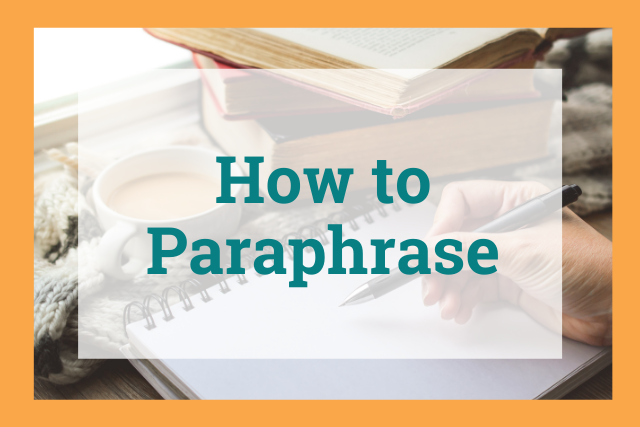
Paraphrasing is a tricky balance between using your own words and still getting the original message across.
Understanding what paraphrasing is, and how to do it well, takes the challenge out of paraphrasing and makes it a more user-friendly skill.
What Is Paraphrasing?
How to paraphrase in 5 easy steps, paraphrasing different types of content, paraphrasing examples, want to improve your essay writing skills.
The word paraphrase can be used as a noun or a verb .
A paraphrase (noun) is a restatement of someone else’s words into other words . If you’re reading a paraphrase, you’re reading someone else’s rephrasing of the original.
To paraphrase (verb) is the act of rephrasing a statement into your own words . When you paraphrase, you are essentially borrowing someone else’s ideas and putting them into your own words. Since you’re borrowing and not creating those ideas, be certain to give credit to the original source.
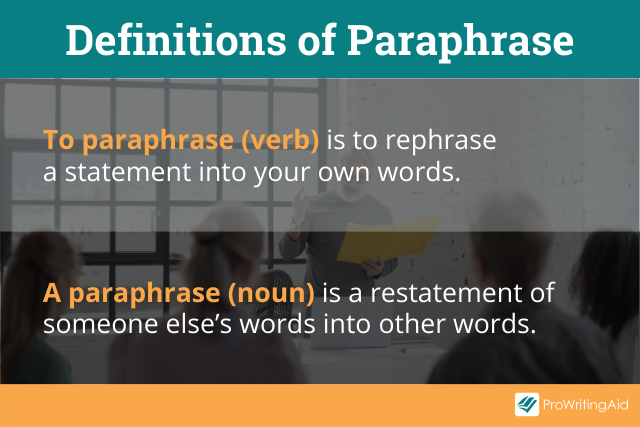
Paraphrasing vs. Plagiarism
Plagiarism is when you steal someone’s words or ideas. Some people think that it’s only plagiarizing when you use the exact words.
Paraphrasing isn’t a way to steal someone’s ideas by putting it in your own words. If you’re paraphrasing someone else’s ideas, you must give them credit.
If you don’t acknowledge that source, you’ve plagiarized, which has serious ethical, and even legal, implications.
ProWritingAid can help you keep your work plagiarism-free with its plagiarism checker , and will never store or resell your work as some other plagiarism checking services sometimes do.
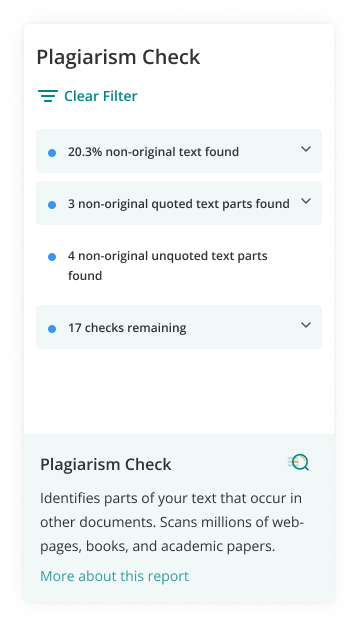
How to Paraphrase Properly
Why paraphrase when you could just use direct quotations? Direct quotes in academic writing and research papers do not demonstrate that you understand the original material.
Proper paraphrasing doesn’t mean rewriting the original passage word for word. It’s more than just pulling out a thesaurus. You are rewriting the ideas in your own words.
Just as you would provide the source of a direct quote, provide the source of paraphrased information according to whatever style guide you’re following (e.g. APA, MLA, Chicago, etc.) or by including the source within the paraphrase itself.
Typically, you’ll use an in-text citation alongside your paraphrased text, but sometimes you may use footnotes or endnotes.
When you use a direct quotation, it’s important to put the original passage or statement in quotation marks. But paraphrased text does not require quotation marks.
Paraphrasing is translating someone else’s words into your words. If you were to translate a sentence from one language into another going word-by-word, you’d end up with nonsense.
The same thing happens when you paraphrase. You’re performing a translation of sorts.
If you try to translate each word, you’ll end up with a paraphrase that reads more like a “word salad” than an intelligent rephrasing.
Why? When you isolate words, you take them out of their context.
The meaning of a word can change based on its context, so respect that context. Keep ideas whole to keep the original meanings intact.
Here’s what it looks like when you translate word for word.
Original Text: “Life expectancy isn’t set in stone: Both public policy and personal responsibility can tip the scales, experts said.” (Craig Schneider, Newsday)
If I paraphrase that text word-by-word, I could end up with something like this:
Word-by-Word Paraphrase: Human existences are not put in rocks. The pair of non-private systems and individual duty can point the measures, professionals uttered.
That makes no sense. Here’s a more effective paraphrase:
Proper Paraphrase: According to experts, public policy and individual choices can affect life expectancy.
This makes much more sense. Keep the entire context in mind when you paraphrase.
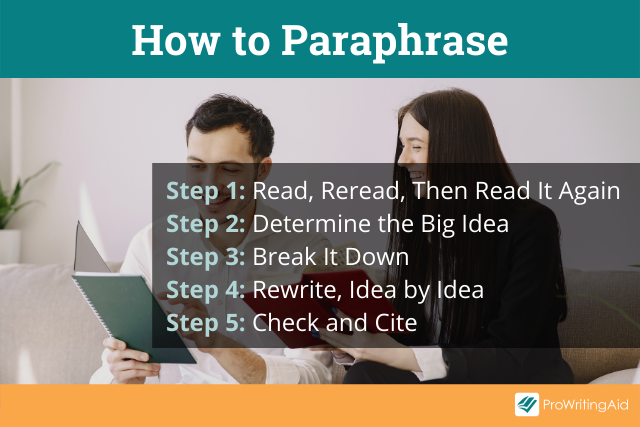
There are some practical steps you can follow to ensure skillful paraphrasing. It might take some practice at first.
As you become more experienced with paraphrasing, you’ll notice that you follow these steps naturally.
Step 1: Read, Reread, Then Read It Again
You can’t properly paraphrase if you don’t fully understand the original passage. For effective paraphrasing, reread the original text multiple times.
Pay attention to word choice and tone, as those contribute to the overarching message. Be sure that you know exactly what the original author was trying to get across before you move on.
Step 2: Determine the Big Idea
There’s a difference between paraphrasing and summarizing, but a quick summary is a great starting point for a paraphrase.
A summary is the main idea. What is the big idea of the original passage?
Try to sum up the big idea in one sentence using your own words.
If you’re only paraphrasing a short chunk of text, this might be the extent of your work and you can skip to step five. For longer quotes, start with the gist.
Step 3: Break It Down
Once you have the big idea, you can start looking at the individual ideas. A good paraphrase includes all the essential information. This is the step where you determine which pieces are essential.
You can start breaking it down sentence by sentence, but keep in mind that you’re really trying to understand it idea by idea.
There might be one idea in two or three sentences or two ideas in one long sentence!
Step 4: Rewrite, Idea by Idea
Once you know all the essential information, it’s time to rewrite. Use your own words and phrasing as much as possible.
Of course, sometimes you will have to use some of the same words. For example, if you’re paraphrasing a quote about the economy, you don’t need to find a new word for “economy.”
Plagiarism isn’t just the words you use, but also the order those words are in.
If you do use more than two of the same words as the original in a row, place them in quotation marks . Avoid this as much as possible for a good paraphrase.
Once you’ve rewritten each idea with the important information, it’s time to make sure your paraphrased version accurately expresses the intent of the original passage.
That leads us to the final step.
Step 5: Check and Cite
Have you ever heard the phrase “lost in translation?” It’s true for paraphrasing, too. Sometimes, when we rewrite something in our own words, we lose the intent and meaning of the original.
Reread what you’ve written and ask yourself the following questions:
- Does this portray the same big idea?
- Have I included all relevant information and ideas?
- Does my paraphrase maintain the integrity of the original’s intent?
- Are all sentences written in my own voice and my own words?
If you can answer yes to all four questions, you’ve successfully paraphrased! If not, return to the quoted material and go through each step again.
Finally, add your citation. Always credit the original source so you don’t plagiarize.
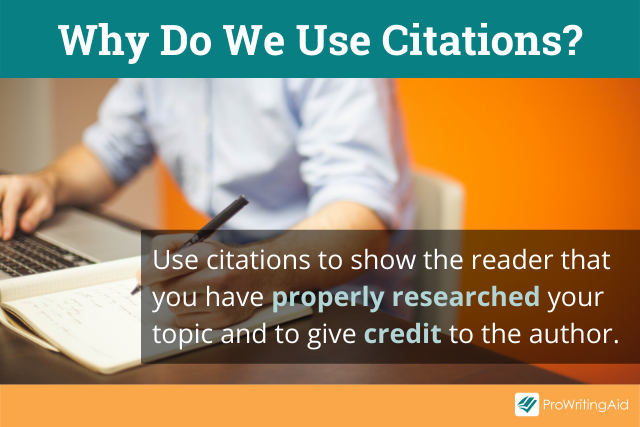
While the same basic steps apply no matter what you’re paraphrasing, it will look a little different depending on the type of text and why you’re paraphrasing.
Let’s take a look at three common situations that require paraphrasing.
How to Paraphrase in an Essay
Essays require paraphrases of many different quotes and sources.
While the occasional quote is fine, frequent direct quotes suggest that you don’t fully understand the material.
Your professor wants to know that you comprehend the subject and have thoughts of your own about it.
To paraphrase in an essay, start with a reasonable sized quote.
If the entire quotation is too long, your essay will become one giant paraphrase. You can always paraphrase another piece of the original text later in your paper.
Make sure the quote you are paraphrasing fits your thesis statement and is in the correct section of your essay.
Then, follow the five steps above to write a paraphrase. Don’t forget to cite your source material!
After you’ve paraphrased and cited the original text, offer your own commentary or thoughts.
How does that paraphrase answer the prompt of your research paper or support your argument? Original thoughts are crucial so your whole essay isn’t a paraphrase. That would be a form of plagiarism!
How to Paraphrase a Quote
Paraphrasing a quote requires you to pay special attention to the tone. Quoted material for academic writing often has a dry, informative tone. Spoken quotes usually don’t.
When you’re determining the big idea (step two), also determine the tone. You can note the tone in your paraphrase by saying the speaker was impassioned, angry, nostalgic, optimistic, etc.
When you move to step three and break down the ideas, pay attention to where the speaker placed emphasis. That’s a clue that you’ve found essential information to include in your paraphrase.
How to Paraphrase Complex Text
Complex and highly technical text can be difficult to paraphrase. All the same steps apply, but pay special attention to your words and sentence structure when you rewrite.
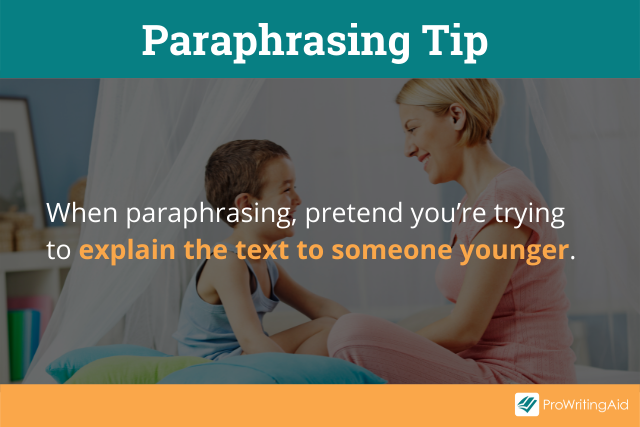
Whenever possible, simplify the complex text in your paraphrase.
Paraphrases are useful because they can make something easier to understand. Imagine that you are explaining the complex text to a middle school student.
Use simplified terms and explain any jargon in layman’s terms. Avoid clichés or idioms and focus only on the most essential pieces of information.
You can also use ProWritingAid’s editing tool to run a Jargon Report and a Cliché Report, as well as readability.
We use the Flesch-Kincaid Scale for readability , which is based on U.S. grade levels. You can see how old someone needs to be to understand your paraphrasing.
Your level of readability might change depending on the purpose of the paraphrase.
If you are paraphrasing complex text for a college-level essay, your readability score can be higher. If you are paraphrasing for a technical audience, some jargon is appropriate.
Let’s take a look at a couple of examples of properly paraphrased material.
Original Text : “Life expectancy isn’t set in stone: Both public policy and personal responsibility can tip the scales, experts said. Everyone can make choices that increase the odds of a longer life, said Cantor, of the Center for Socio-Economic Policy. Eating well, exercising, not smoking, getting enough sleep and staying in school are decisions made by each and every one of us, he said.” (Craig Schneider, Newsday )
Paraphrase: People do have some control over their life expectancy. While public policies matter, experts say personal choices can also affect how long you live and that making healthy lifestyle choices about food, sleep, education, and smoking is up to each individual.
Here’s another example from a speech.
Original Text: “We’ve got to accelerate the transition away from dirty energy. Rather than subsidize the past, we should invest in the future—especially in communities that rely on fossil fuels. That’s why I’m going to push to change the way we manage our oil and coal resources, so that they better reflect the costs they impose on taxpayers and our planet.” (President Barack Obama, State of the Union Address, January 12, 2016)
Paraphrase: President Obama emphasized the importance of investing in clean energy. He supports a shift in the way the country manages non-renewable resources to match the impact they have on both American citizens and the planet.
Remember, when you paraphrase, focus on the ideas, not rewriting word for word. Always cite your original source material even though you are using your own words.
(This article is an update to a previous version by Allison Bressmer.)
Use ProWritingAid!
Are your teachers always pulling you up on the same errors? Maybe you’re losing clarity by writing overly long sentences or using the passive voice too much.

Be confident about grammar
Check every email, essay, or story for grammar mistakes. Fix them before you press send.
Krystal N. Craiker
Krystal N. Craiker is the Writing Pirate, an indie romance author, editor, and book mentor. She sails the seven internet seas, breaking tropes and bending genres. She has a background in anthropology and education, which brings fresh perspectives to her romance novels. When she’s not daydreaming about her next book or article, you can find her cooking gourmet gluten-free cuisine, laughing at memes, and playing board games. Krystal lives in Dallas, Texas with her husband, child, and basset hound.
Get started with ProWritingAid
Visit our Help Center or let's stay in touch via:

IMAGES
VIDEO